Sram has some wild new ideas, patents suggest
An aero gravel suspension fork, thru-axle batteries and solar-powered mudguards

When it comes to being a market leader in a segment, constant innovation is necessary in order to maintain that position. If you're standing still, you're moving backwards - the old adage goes.
Each innovation will begin as a simple idea, and as that concept goes through the various steps of becoming a reality, brands seek to protect their idea with a patent – or a series thereof.
Thanks to various free online patent-viewing resources, this provides the general public with a glimpse into the minds of our favourite brands; and a veritable treasure trove of concepts, ideas, and cool new future tech.
One brand in a market-leading position is American groupset manufacturer, Sram. While younger than its main rival, Shimano, and with a smaller share of the overall groupset market, Sram is just as entrenched in performance-level road and mountain bike groupsets, and has firmly cemented itself as one of the 'Big Three'; the third position being occupied by Campagnolo.
Sram LLC is also the parent company to a variety of other cycling-related brands such as RockShox suspension, Hammerhead computers, Zipp wheels and more.
Among its latest concepts are a trio of patents pertaining to redesigning gravel bike suspension forks, hidden batteries, and adding solar power too, of all things, mudguards.
Solar-powered AXS battery chargers
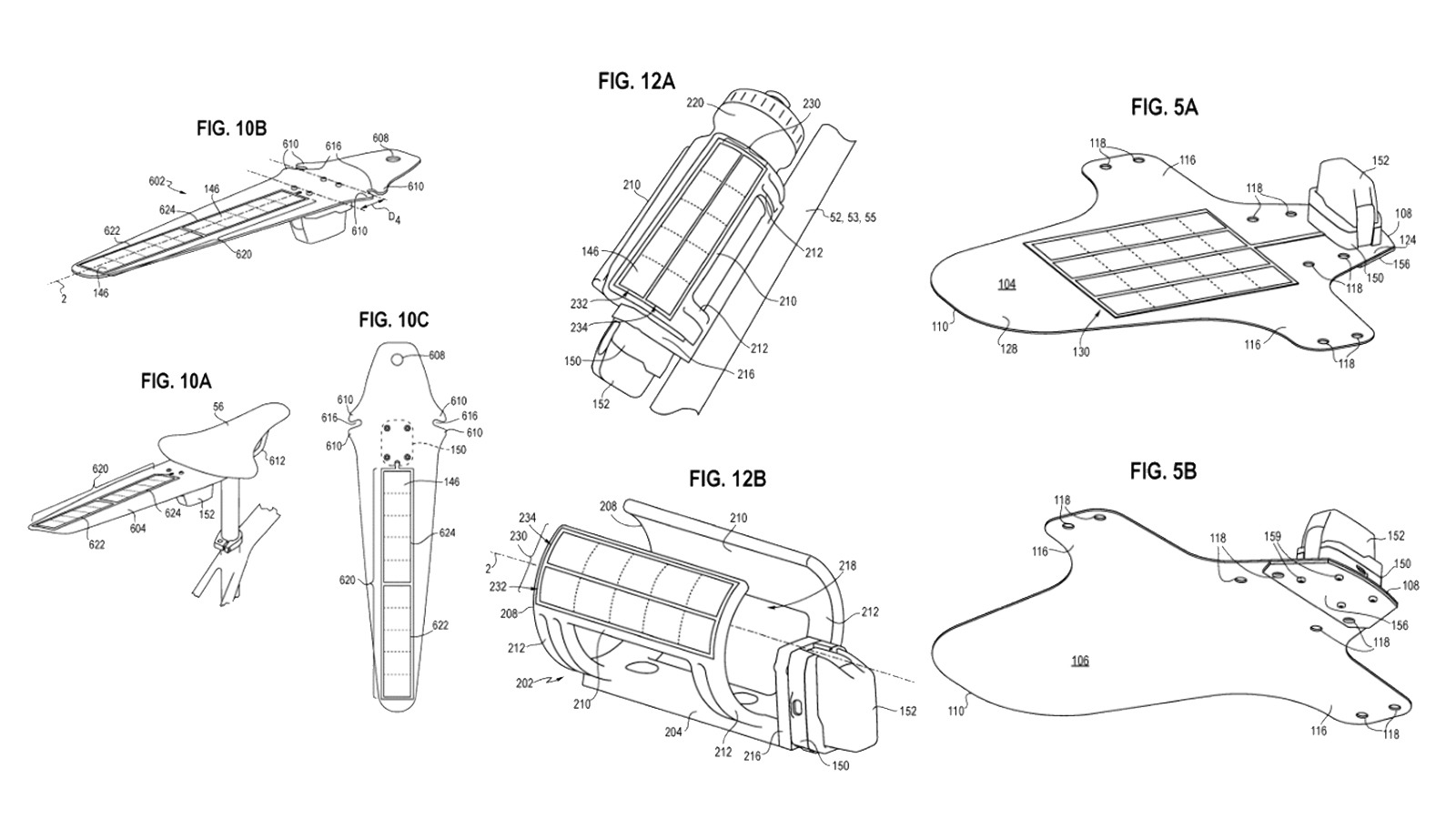
Starting with the latter, it appears the brand is working on embedding solar panels into any spare real estate on the bike, namely mudguards, frame tubes and bottle cages, which would be able to charge AXS batteries via an integrated mount.
The latest race content, interviews, features, reviews and expert buying guides, direct to your inbox!
AXS is the name given to Sram's collection of wireless electronic groupsets. The batteries are proprietary to Sram and are clipped into the various necessary components such as derailleurs and dropper posts. Currently, charging is done via an electric charging station at home, connecting to a power source via a USB cable.
In application number 20220131404, Sram's reason for the invention is given as follows: "Modern bicycles are increasingly equipped with electronic components, such as shifters, derailleurs, power meters, and dropper posts. If the batteries supplying power to these components are not replaced or recharged, they run out of energy and the components cease to function. It may be inconvenient for some riders to have to monitor the state of the batteries and recharge them periodically.
"For this reason, riders may choose to carry a spare battery when riding. However, even these spare batteries naturally discharge, as they provide power to a battery management system (BMS). There are also internal chemical reactions which further contribute to self-discharge. This means that a spare battery may not remain fully charged, even if never used."
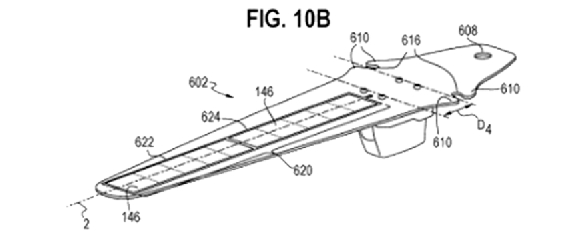
Courtesy of a selection of included diagrams, shown above, the solar-powered chargers in question are seemingly designed for all manner of positions on the bike, from under-saddle spray guards to mud-fenders that sit beneath the bridge on a suspension fork. There's even a bottle cage, and what looks to be a sleeve that can be strapped around a frame tube.
It doesn't appear that the panels can connect to each other to share charge, nor does it appear they have the means to store charge once when a battery is disconnected. It's not confirmed how much charge each solar panel is able to provide in optimal sunlight, and therefore, it's unclear whether the panel is able to provide an endless supply of power to, for example, those bikepacking in the wilderness, or whether it's solely designed to offset the self-discharge mentioned above.
Aero gravel linkage fork

The second, patent number 20220355894, takes the form of a linkage-based suspension fork, seemingly designed with gravel bikes in mind.
Within the application, Sram details the arguments against using traditional telescopic suspension fork designs on a gravel bike, citing a lack of small-bump effectiveness and poor aerodynamics as the main reasons. This is despite Sram's subsidiary company RockShox making an existing telescopic gravel fork, the Rudy.
"In general, larger suspension systems result in lost power from pedaling because the front fork compresses during pedaling. Further, in these known telescoping tube forks, the spring and the damper require a certain breakaway force before the upper and lower leg tubes begin to move relative to each other. With bicycles ridden mainly on the road, for example, this amount of force may not be met and, thus, smaller bumps and vibrations (e.g., from gravel) are transmitted through the bicycle to the rider. Moreover, the telescoping motion of multiple, linear moving structural members requires extra overlapping length and, therefore, the leg tubes must remain parallel at a width greater than the hub. This is a disadvantage in that the leg tubes cannot be any narrower than the widest part of the wheel, thereby increasing the visual width and aerodynamic drag of the bicycle."
Sram's application also mentions 'other known fork designs' including 'flexing members' and linkages. However, it argues that these types are not structurally connected. "In use, when side loading due [to] cornering or bumps occurs, the lower members move relative to each other leading to the wheel position and/or suspension trajectory moving out of center plane of the bicycle, which results in imprecise steering behavior."
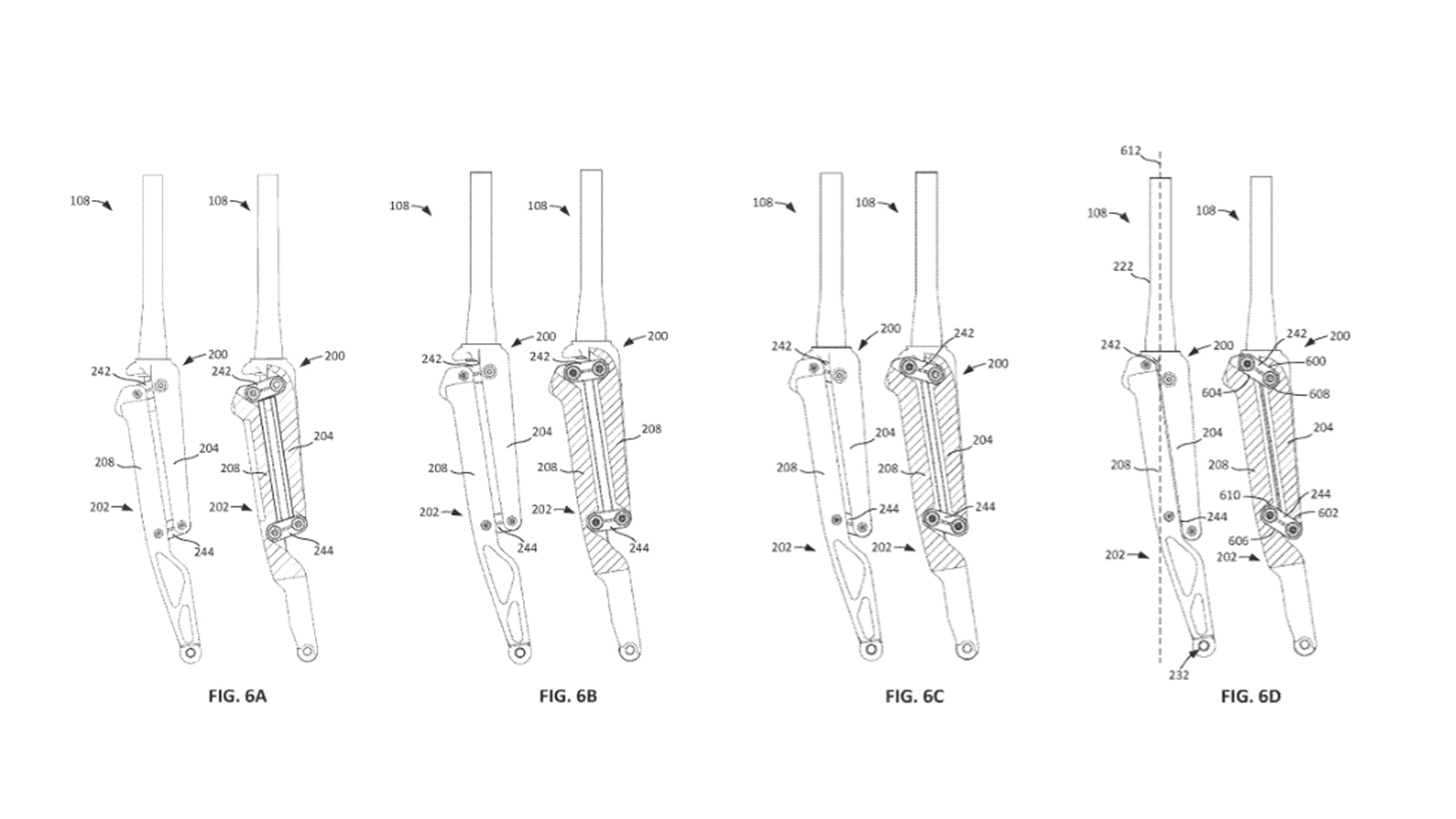
Therefore, the design here has connected the upper and lower via two pairs of links and bearings. The forks upper sits in front of the lower, with the linkages allowing vertical movement. At the top of the lower, a bridge connects the left and right legs, inside of which is a damper to cushion the movement. There is also a narrowing of the fork, as well as an aerodynamic shape to the legs, rather than the cylindrical shape found in telescopic models.
Due to the mention of gravel above, and the main image for the application using a diagram of what appears to be a gravel bike, we're confident that's where this fork will find itself, should Sram follow it through to production.
Thru-axle batteries
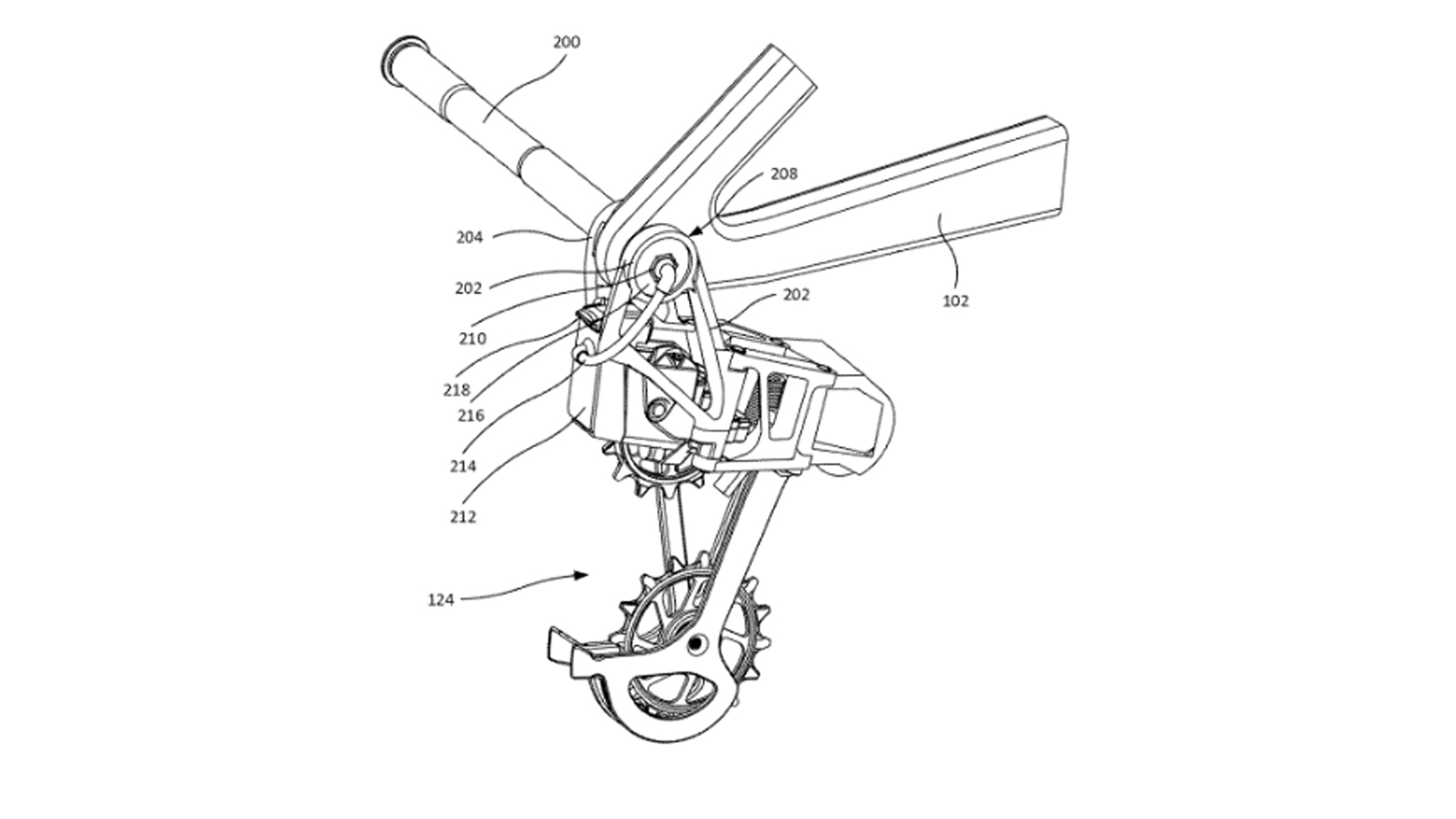
In this third application - number 20220194509 - Sram is looking to replace the AXS battery with one placed inside the thru-axle, which connects to the derailleur via a small cable.
According to the application, this battery position could theoretically solve the power needs of multiple components, not only the nearby rear derailleur, including the "seat post, bicycle lighting, an air pump, a GPS transponder, a shock, or other."
Sram says "traditional power supplies may add unbalanced weight to the bicycle," while also potentially being exposed to the elements or impacts. "Traditional power supplies may be limited in size to reduce unbalanced weight or reduce the likelihood of impacts, thereby limiting the capacity of the power supply," it continues, and that positioning a battery within an axle could be the solution.
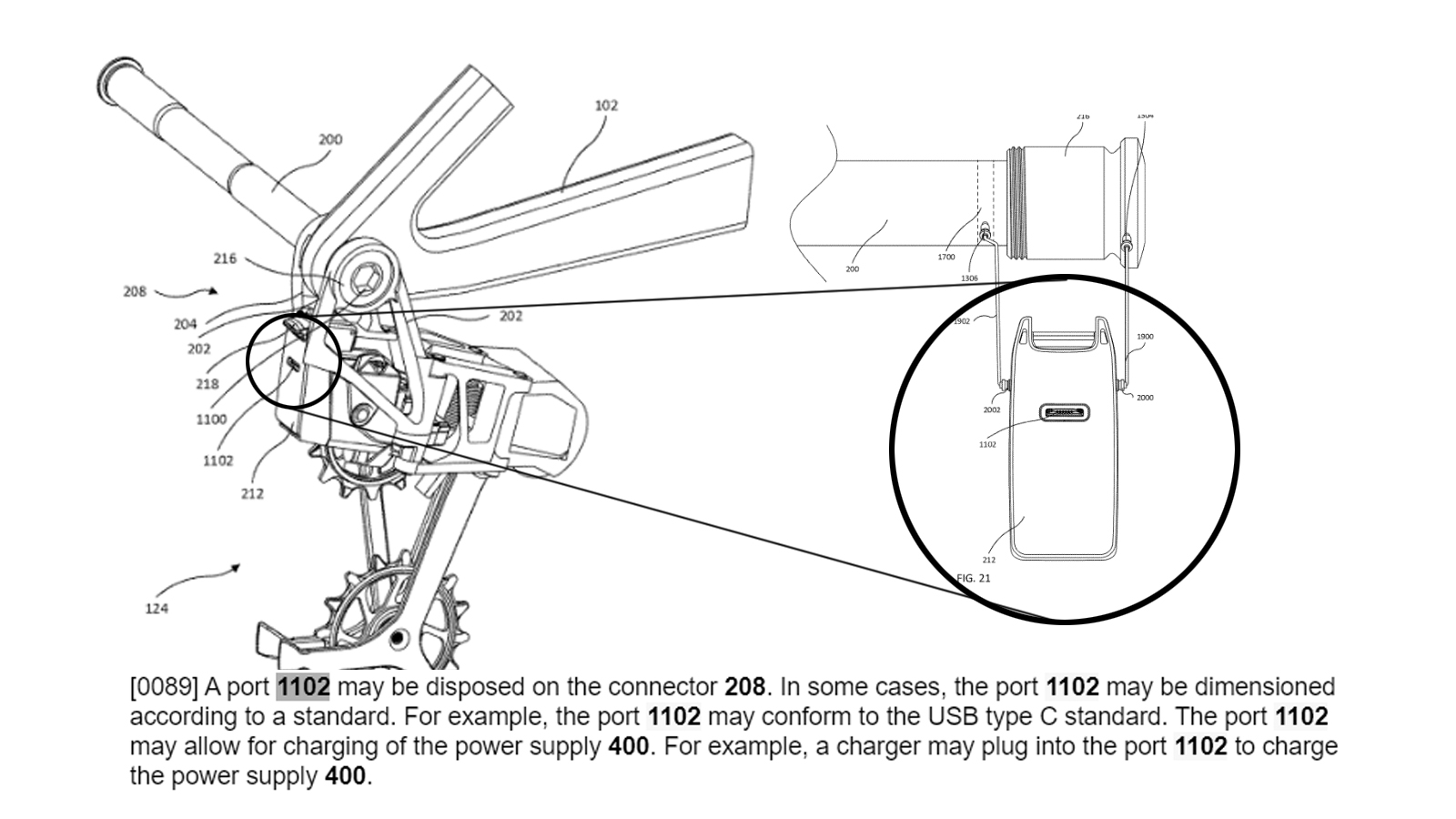
When will we see this tech on our bikes?
Potentially never, unfortunately. The patent application step is almost always very early on in the process of taking an idea and making it a reality. Naturally, not all ideas make it across the finish line, so we cannot say with any certainty that any of these ideas will eventually make it onto bikes.
However, it does tell us that Sram isn't resting on its laurels. Like its competitors, the American brand is continuing to push the boundaries of what's possible with bike design and what its customers need.

Josh is Associate Editor of Cyclingnews – leading our content on the best bikes, kit and the latest breaking tech stories from the pro peloton. He has been with us since the summer of 2019 and throughout that time he's covered everything from buyer's guides and deals to the latest tech news and reviews.
On the bike, Josh has been riding and racing for over 15 years. He started out racing cross country in his teens back when 26-inch wheels and triple chainsets were still mainstream, but he found favour in road racing in his early 20s, racing at a local and national level for Somerset-based Team Tor 2000. These days he rides indoors for convenience and fitness, and outdoors for fun on road, gravel, 'cross and cross-country bikes, the latter usually with his two dogs in tow.